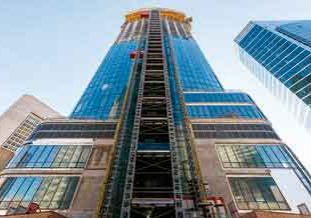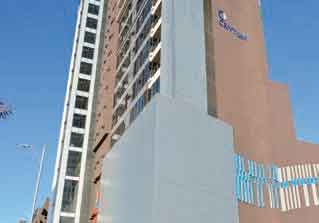In this Industry Dialogue, an expert shares his informed opinions with EW.
If anybody knows escalators and moving walks, it’s Ken Smith. Running consultancy Ken Smith & Associates out of the tiny town of Preston, Iowa, Smith is a mechanical engineer who has been involved in the industry for more than 30 years. Since 2000, he has consulted on over 200 cases and 235 claims, testified via deposition more than 30 times and testified in court eight times. He is a member of the ASME Safety Code for Elevators and Escalators and Moving Walks Committee and holds numerous patents, including for an escalator handrail drive device and air-flotation newel. In 2015, he joined John W. Koshak and Daniel Swett in forming eMCP, which provides an electronic maintenance control program for vertical transportation (VT) required by the ASME A17.1/CSA B44 Safety Code for Elevators, Escalators, Dumbwaiters, Moving Walks and Material Lifts. In this Industry Dialogue, Smith (KS) shares with ELEVATOR WORLD (EW) his informed opinions on escalator and moving-walk safety gleaned during his decades in the industry.
“Brushes may help minimize entrapments but are not a substitute for the unit having as low an index as possible.”
EW: What are the standard guidelines for escalator maintenance? What needs to be checked, when and by whom?
KS: First, there is the A17.1/B44 code. Section 8.6 of the code covers maintenance, repair, replacement and testing. For escalators and moving walks, Section 8.6.8, “Maintenance and Testing of Escalators and Moving Walks,” gives general maintenance requirements. In addition, there is Section 8.6.9, “Maintenance of Moving Walks.” Some states have their own codes. However, most are design and installation related. Now, they either reference A17.1/B44 or are being replaced by it. Manufacturers have specific maintenance requirements for their equipment, as well.
EW: Is there any particular location where maintenance is absolutely critical — both to prevent injury and litigation?
KS: Maintenance is critical in all locations to prolong the life of the equipment and prevent injury and resulting litigation. Units in public-transit facilities (train stations, airports and the like) typically operate for more hours per day and suffer more abuse than similar equipment in malls or office buildings. For these reasons, public-transit units require more frequent maintenance and repair. However, all escalators and moving walks should have monthly maintenance to ensure things like handrails, comb teeth, and step/pallet rollers are in good condition.
Outdoor units can require different maintenance than indoor units. A dry, desert environment can expose the mechanical components to more dust and dirt, possibly causing an increased wear rate of chains and exposed gearing. Units in a salty environment may have corrosion issues. I have seen units with severely corroded aluminum landing plates and steel trusses. Units in colder climates that are not protected properly can be subject to water and ice. I worked on an water and ice. I worked on an in the winter so the handrails would not freeze to the guides and stop moving.
Maintenance is not ‘one size fits all’ and should be tailored to each particular unit as the code requires in Section 8.6. The code considers age, condition, wear, design, quality, usage, environment, technology and other characteristics when developing a maintenance control program to properly identify maintenance requirements and frequency.
EW: What parts of an escalator present the most potentially dangerous problems, and what are the root causes?
KS: The machine room or pit may be dangerous for a mechanic because of the moving machinery or contact with high voltage, but, for the general public, the parts of an escalator or moving walk that are accessible to them as they use the equipment can be dangerous if a failure occurs, or as a result of improper maintenance.
The most common accidents on escalators are falls. Some falls occur due to no fault of the equipment. However, some are related to the unit stopping too quickly. Since A17.1B-1983, escalators have been required to stop at a maximum rate of 3 fps2 in the down direction, with no deceleration requirement in the up direction. In my experience, if a unit stops at a rate higher than 3 fps2, the probability of falls increases. If the deceleration rate is higher than allowed, the root cause is typically the brake or the brake not being properly adjusted.
Brakes have been known to operate with less-than-sufficient torque to stop the unit as intended. On an escalator with a significant passenger load, this situation can lead to an overspeed or runaway.
Typically, the accidents that lead to the worst injuries are entrapments. Comb and step/skirt entrapments are the most common. I have also been involved in a few cases of handrail entrapment.
Comb entrapments usually involve shoes or fingers becoming caught between the comb teeth and steps/pallets. I have also seen cases where a person’s clothing has been entrapped, causing serious injury, sometimes even death. A unit with unbroken comb teeth, comb teeth that are properly engaged with the steps/pallets, no damaged treads/risers and step rollers that are in good shape are less likely to entrap objects than a unit that has not been properly maintained. The root causes are typically:
- Broken comb teeth
- Insufficient engagement of the comb teeth with the steps/ pallets
- Broken or damaged treads/risers
- Damaged step/pallet rollers
I have also seen entrapments caused by improper track spacing at the comb, causing the steps to enter the combs with the treads low at the nose and high at the trailing edge, actually pushing an object into the comb. The comb teeth should be adjusted to engage with the steps per the manufacturer’s specifications, which require much more engagement than the code. The code specifies only that “the points of the teeth are always below the upper surface of the treads.” It is always good to check the comb engagement with the “business card test” described in A17.2.
EW: What are some other entrapment hazards?
KS: Step/skirt entrapments can also lead to serious injuries. When an object, (typically a hand, calf or foot) is pressed against the skirt, forces related to the geometry of an escalator with a stationary skirt and moving step can cause objects to be pulled into the gap between the step and the skirt. The root causes of this type of entrapment are a combination of the following factors:
- Static gap between the step and skirt
- Skirt deflection
- Side-to-side step movement (sometimes known as deadband)
- Coefficient of friction between the object and skirt
For shoe entrapment, besides the coefficient of friction, the pliability of the shoe has an effect. The more pliable a shoe, the easier it is entrapped. The root cause of step/skirt entrapment is an escalator with one or a combination of the following:
- Large step/skirt gap
- Easily deflecting skirt
- High-friction skirt
- Large step deadband
For many, many years, the code has had requirements for step/ skirt gap, skirt deflection and skirts that require lubrication or are made from a low-friction material. Since A17.1D-1996, the code has required the Step/Skirt Performance Index Test be performed. Basically, the test considers the factors relating to entrapment and determines the escalator’s likelihood to entrap an object. If an escalator has a low index, i.e., one that is less than or equal to .15, it is less likely to entrap.
It is important to remember that when the study that led to the index requirements becoming part of the code was performed, shoes with the characteristics of CrocsTM had not yet been marketed. These shoes, because of factors like the coefficient of friction between the shoe and the skirt, and their pliability, make them more likely to become entrapped than other types of shoes. In addition, they are more likely to be worn by children, who are often not aware of step/skirt entrapments.
EW: How can entrapment hazards be mitigated?
KS: An index test should be regularly performed (more than once a year), and the escalator maintained to achieve a low index. Depending on the vintage of the escalator and the code adopted by the AHJ, escalators with an index of greater than either .25 or less than .4 must have skirt brushes. Brushes may help minimize entrapments but are not a substitute for the unit having as low an index as possible. In regard to the index test, I have noticed that many performing the test are doing so incorrectly, therefore providing bad data to the AHJs.
Handrail entrapments are relatively rare. The root causes I am aware of are gaps between the handrail and balustrade, handrails coming off of the guides, and damaged handrails or inlets.
EW: What should be on an escalator inspector’s checklist?
KS: Escalator and moving-walk inspectors should be inspecting equipment per the guidelines laid out in the A17.2 Guide for Inspection of Elevators, Escalators, and Moving Walks. Some advanced equipment may have special requirements as determined by the manufacturer. The quality of inspection can vary dramatically by jurisdiction or company. It is always best to use knowledgeable inspectors, even though they may uncover more violations that need to be remedied.
EW: How easily are such problems rectified?
KS: Most problems discovered during an inspection (i.e., broken comb teeth, chipped treads or bad rollers, just to name a few) have easy solutions. However, some violations/problems require replacement of the handrails or step/pallet chain, which can be quite costly. In my experience, it is rare to discover and have to correct violations at the time of installation. Usually, they are from wear over time or minor damage from use.
EW: Does a longer/steeper escalator equal more problems? Why or why not?
KS: In North America, escalators are designed for a maximum inclination of 30° (with a tolerance of 1°). In Europe and other places that use the EN 115 standard, units with a 6-m rise or less can have a maximum inclination of 35°. The risk of falls from stops in the down direction on an escalator with a 35° inclination may be slightly greater. Loading may be slightly different for a steeper inclination, but the effects would be negligible.
EW: What is the biggest obstacle to equipment owners/operators performing proper maintenance?
KS: Money plays a big part in the quality of maintenance. I have been hired to help correct problems for several customers where the maintenance provider has underbid the job and doesn’t have the money to perform proper maintenance, or, on the flipside, is making money by not performing the maintenance required by the contract. In either case, maintenance, and the condition of the equipment, suffers.
As we discussed earlier, having a knowledgeable inspector is a plus to keep the units in safe operating condition. Hiring a conscientious, reputable maintenance company that properly documents its work and paying them enough for proper maintenance is very important to keep the equipment in safe operating condition. Such companies are most likely hiring only trained, motivated technicians. An equipment owner should also have the ability to easily check to see if maintenance is being performed per the contract. Koshak, Swett and I started eMCP, LLC to make sure that all VT units receive code-required maintenance and testing and that it is documented as required by code in an easy-to-use system, and that the records can be easily accessed by the equipment owner.
EW: Does the same entity that performed the inspection typically also perform repairs?
KS: With most AHJs, the maintenance company performs the actual inspection and tests, while a licensed inspector witnesses them. In other cases, the maintenance company does the inspection and sends the results to the AHJ without an inspector witnessing anything. Talk about the fox guarding the henhouse! The worst case that I have seen is where the mechanic that performed the regular maintenance also performed the inspection, and was the licensed inspector! That’s always a bad idea.
Get more of Elevator World. Sign up for our free e-newsletter.









